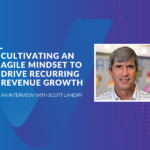Customer Success Needs To Be A C-Level Strategic Priority
Ready to put your organization on the fast track to exceptional revenue growth? A recent study by Deloitte found that ⅓ of enterprise businesses saw a 20% uptick in Annual Recurring Revenue as a result of embracing and championing their Customer Success function (2019). By implementing this strategic motion, you can be among peers that are leading a successful customer success organizational transformation and set up your own business for long-term revenue growth and expansion.
An Organizational transformation can be tricky. To help you champion a successful program, we turned to 5 seasoned professionals with industry experience from the ranks of Splunk, Apptio, Datto and Valuize. In this article, they answer burning questions from the community about how to drive an organization-wide CS transformation and accelerate revenue growth through a powerful scale engine.
Q: What’s your recommended approach to aligning Customer Success and Sales beyond giving Customer Success Managers (CSMs) expansion and renewal dollar targets?
“I don’t think CSMs need to have renewal targets to be part of the renewal process,” shares Scott Landry. “I’ve always found that the best way to get Sales and Customer Success aligned is to have the conversations that find common ground between the two, in terms of deliverable outcomes. Retention is a huge number so it may not be the sole responsibility of the Success organization; instead, this can be something that is shared by the entire organization. CS, for their part, can measure the value objective that they’re involved in during the renewal process. For example, CS can determine that if someone has a poor health score, they’re going to reach out 90 days before renewal. Or, if CS knows that the customer is under-utilizing a product based on a certain adoption metric, they can plan to proactively reach out 6 months before renewal. So, there are things that you can drive within the CS organization that are very success-oriented, tactical and measurable that can showcase the correlation between your initiatives and renewal rates. CS doesn’t have to own that number, but they can work with other teams jointly towards that overarching goal. That’s what leads to true organizational transformation”
“Just as importantly, find out what’s valuable for your employees,” advises Elizabeth Lee. “Customer Success teams as a whole aren’t nearly as concerned about expansion dollar value as Sales is, so explaining your strategy in a way that is relevant and meaningful to each party is paramount. For example, Customer Success teams are very focused on relationship building, so they don’t want a one-and-done Sales process and instead prefer to nurture and grow existing accounts. The strategy that you’ve identified needs to speak to that. It’s not always about the dollar value for aligning targets. Other ways to incentivize and approach the connection between CS and Sales is focusing on what’s valuable for your employees.”
Q: Is the Customer Success Plan a good tool to share and conduct that internal alignment between Sales and CS?
“My experience is that success plans become mostly a Customer Success tool. unless there’s some number driven from it, Sales don’t tend to use success plans because they’re generally located in a different system. I’ve faced challenges trying to get Sales teams to integrate with Customer Success on success plays within the CS designated platform. Usually, if you want to do something like that, you need to operationalize it through a Sales automation software. You have to remember that even if both teams are aligned around the customer and the success of the customer, they often have very disparate systems and different ways of being measured on their success. When you’re trying to tackle alignment and organizational transformation, a success plan is not something I’d add to the top of the list because operating across different systems creates a host of problems. However, the participation of both teams in building the success plan is a great first step,” recommends Scott.
According to Liz, “When you’re considering your technology investments, you need to ensure that your systems can provide a centralized source of truth. For example, if your organization uses Salesforce, then Gainsight is beneficial as it enables direct integration between the two platforms. This enables your CS team to directly share information with Sales, and vice versa.”
Q: What are the tools that you use to help with your scaling engine?
“At Splunk, a key platform for us is the Gainsight platform,” Amin Chaundry says. “That is the primary tool and technology that we use to drive our Customer Success motion and to collect insights from the data that tells us how we’re doing and what we need to do to keep customers happy and satisfied”.
“Having a CSM platform definitely helps ensure that you’re actionable here,” advises Emily Ryan. “As far as data and insights, make sure that you’re capturing and collecting that data from as many different places in the ecosystem as possible and acknowledge that every engagement is a data point for your customer. So, whether you want to measure this via surveys, marketing email metrics or CS or Support engagement data, all of this information is critical in addition to your product insights.”
According to Kevin, “The other thing that is critical is the knowledge base. Use cases and outcome knowledge, like outlining a set of use cases or a plan to execute and implement your use cases, is essential. This allows your customers to look at a repository of knowledge around value outcomes and the recipe to achieve success. This also helps your upmarket customers; you can leverage the resources for your down markets and start applying it to your upmarket customers, which can really help drive scale.”
Q: What are a few examples of tools used to capture product adoption and the metrics needed to measure it properly?
“When you think about the subscription model, customer telemetry is everything. If your business and customers operate in a cloud environment where you can capture and analyze telemetry data, that’s a huge advantage. This is the machine-recorded data sources that we use to formulate an understanding of health and get an overall sense of how the customer is doing. There’s also human-qualified customer insights; I think it’s helpful to have a human-qualified customer sentiment that’s been verified and checked,” suggests Amin.
“In terms of product adoption, a lot of it is going to come from your product telemetry itself. That said, there are other products like Pendo or Gainsight PX that can help augment your customer engagement data set. These are usually embedded in the product itself and augment the telemetry data that you may not otherwise have access to. You can also leverage human insights and data capture; while it’s not the most scalable approach, it’s a good place to get started if you don’t have any data or if your platform is entirely on premise,” shares Emily.
Kevin adds, “Don’t forget your Support data as it can provide some valuable insight into your customers, especially in regards to product usage. Product Telemetry is really important, whether it’s something you craft yourself through engineering or whether you use a separate platform, but don’t forget about some of those other sources like your Support data.”
Q: What type of person do you think succeeds as a digitally-led CSM? Is there a profile that’s different from a CSM dealing with lower client ratios?
Amin shares, “We staffed for the CSM team to be that advocate for customers that are going through a digital journey. At Splunk we considered three key criteria; does this person have good customer engagement and communication skills? Does this person have experience helping customers utilize technology or a product to help solve their business challenges? And, does this person have fundamental knowledge of the CS domain?
For more expert insight on driving a successful organizational transformation, hear from these extraordinary leaders as they share their advice for championing an organization-wide CS transformation and accelerating revenue growth by scaling a digital customer engagement model.
Lead A Triumphant Organizational Transformation
The recurring revenue landscape is volatile and unpredictable. Your organization has to be structured in such a way that it is not only able to meet the challenges of the future but also thrive and excel. By transforming to a cross-functional approach to success, you can build a powerful digital engagement model that allows you to grow and expand with your customers and your business at scale.
A successful Customer Success program and strategy is rooted in clearly defined customer value. Read our article about how to align your team, tools and processes around customer value creation.





